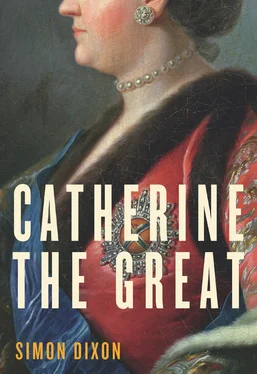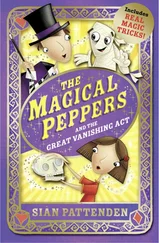Readers of Russian will learn much from attractively written books by Evgenii Anisimov, Zhenshchiny na rossiiskom prestole (St Petersburg: Norint, 1998), and Aleksandr Kamenskii, Pod seniiu Ekateriny: Vtoraia polovina XVIII veka (Moscow: 1992), the first study of Catherine’s reign to be published in Russia since the Bolshevik revolution in 1917. Despite its title, V. S. Lopatin, Potemkin i Suvorov (Moscow: Nauka, 1992) has just as much to say about Catherine: this book’s rehabilitation of Potëmkin, based on the author’s excellent editions of the correspondence of the two men, underpins the argument of Montefiore’s English biography. More specialised are the work of the legal scholar, O. A. Omel’chenko, ‘Zakonnaia monarkhiia’ Ekateriny II: Prosveschennyi absoliutizm v Rossii (Moscow, 1993), and two studies of the relationship between literature and politics by Andrei Zorin, Kormia dvuglavogo orla: Literatura i gosudarstvennaia ideologiia v Rossii v poslednei treti XVIII—pervoi treti XIX vek (Moscow: Novoe literaturnoe obozrenie, 2001), and Vera Proskurina, Mify imperii: literatura i vlast’ v epokhu Ekateriny II (Moscow: Novoe literaturnoe obozrenie, 2005), who is not always quite so convincing. In the late 1880s, V. A. Bilbasov completed only two volumes of what promised to be a massive biography before running into trouble with the censors. His Istoriia Ekateriny Vtoroi , 2 vols (SPb-Berlin, 1890–91), remains the most detailed study of Catherine’s life before 1763. The troubled relationship between Catherine and her husband is explored in unprecedented detail by O. A. Ivanov, Ekaterina II i Petr III: istoriia tragicheskogo konflikta (Moscow: Tsentrpoligraf, 2007), a book which reached me just as my own went to press. Ekaterina II: Annotirovannaia bibliografiia publikatsii , eds. I. V. Babich, M. V. Babich and T. A. Lapteva (Moscow: Rosspen, 2004), is an invaluable guide to the voluminous published sources on Catherine and her reign. Students of St Petersburg will find a very helpful bibliography of Russian work by A. M. Konechnyi in Europa Orientalis (1997, no. 1). No less crucial for the history of eighteenth-century Russian painting is the illustrated catalogue of the State Russian Museum in St Petersburg—Gosudarstvennyi russkii muzei, Zhivopis’: XVIII vek , ed. Grigorii Goldovskii (St Petersburg: Palace Editions, 1998)—which carries a limited amount of summary information in English.
It may never be possible to acknowledge all the influences which lie behind the publication of a book such as this. I certainly cannot do so here. But I should never have begun it without help from Jon Jackson and Sam Johnson, and I could not have finished it without support from Catherine Beaumont. Much of it was written while I was chairman of the School of History at the University of Leeds, and I am deeply indebted to all my former colleagues there for their tolerance and encouragement. In particular, I received invaluable bibliographical advice from Simon Burrows, John Chartres, Emilia Jamroziak and Phil Withington (now of Christ’s College, Cambridge), and unstinting support from John Childs, Gordon Forster, John Gooch, Katrina Honeyman, Kevin Linch, Graham Loud, Angela Softley, Edward Spiers, Andrew Thompson, Ian Wood and Anthony Wright. Richard Davies is an incomparable fount of wisdom in the Special Collections Department of the Brotherton Library, which boasts some of the most impressive Russian holdings in the United Kingdom. Among friends and colleagues in the international Study Group on Eighteenth-Century Russia, Paul Keenan generously permitted me to quote from his unpublished doctoral thesis, and I owe a continuing and mounting debt to Roger Bartlett, Anthony Cross, Elise Kimerling Wirtschafter, Joachim Klein, Isabel de Madariaga, Gary Marker, Gareth Jones, Patrick O’Meara, Viktor Zhivov and Andrei Zorin. For all its imperfections, this book would have been much the weaker without their help and example.
Though I have made regular journeys to Moscow and St Petersburg in recent years, much of the reading for this book was done in the Cambridge University Library, the British Library and the National Library of Finland on visits made possible by the University of Leeds. In Helsinki, I owe a profound debt to Marina Vituhnovskaja, Timo Vihavainen, Irina Lukka and her colleagues. In Cambridge, my friends Derek Beales and Tim Blanning still inspire just as much awe and respect as they did when they taught me thirty years ago. In London, my late friend Lindsey Hughes and her husband Jim Cutshall gave me some of the most memorable evenings of my life and much more besides. If there were any justice in the world, Lindsey would occupy the chair I now hold.
Three special obligations remain. Peter Carson has been an unfailingly patient publisher, even when he had grounds to be apoplectic. At home, Stephanie, Oliver and Rachel have been equally uncomplaining, even when the writing took longer than they had any reason to expect. The dedication acknowledges a debt that I shall never be able to repay, to two people who have sustained me for as long as I can remember. I owe them everything.
Simon Dixon
London, October 2008
Note: Entries in this index, carried over verbatim from the print edition of this title, are unlikely to correspond to the pagination of any given e-book reader. However, entries in this index, and other terms, may be easily located by using the search feature of your e-book reader.
Ablesimov, Alexander: The Miller-Sorcerer, Cheat and Matchmaker 256, 279
Académie des inscriptions 210
Academy of Dijon 154
Academy of Sciences, St Petersburg, 264
Adams, John Quincy 324
Addison, Joseph 198
Admiralty, St Petersburg 43, 44, 127, 258
Admiralty College, St Petersburg 75, 128
Adodurov, Vasily 51, 105
Adolf Friedrich, Prince Bishop of
Lübeck, King of Sweden 35, 56, 57, 59, 60
Aepinus, Professor Franz 197, 248
Alcibiades 306
Aleksey Mikhailovich, Tsar of Russia 13, 19, 62, 157, 165
Alekseyev, Archpriest Peter 277
Alexander I, Tsar of Russia 134, 273, 284, 299, 317, 320, 320–21, 329
birth (1777) 246
C’s love for him 247, 249, 268, 323
education 248, 249
personality 249
marries Princess Louise 313
promises to rule according to C’s
‘heart and laws’ 321, 325
portraits of 331
Alexander II, Tsar of Russia 323, 329, 330
Alexander III, Tsar of Russia 2, 329, 331, 332
Alexander Nevsky monastery, St
Petersburg 44, 45, 100, 125, 127, 221, 244, 253, 294, 313, 314, 317
Church of the Annunciation 319
Alexander of Macedon 246
Alexandra, Grand Duchess 313, 314
Algarotti, Francesco 42–3
All Sorts (journal) 198–9
Amsterdam 82, 195
Amvrosy, Archbishop 207, 208, 212
Amvrosy, Metropolitan see Podobedov
Ancelin, Nicolas 319
Andrew, St, Apostle 17, 247
Angiolini, Gasparo 191
Anglo-Russian trade treaty (1734, renewed 1766) 187
Anhalt, Count 327
Anhalt-Dessau, Prince Leopold of 26
Anhalt-Dessau, Leopold III Friedrich Franz of 32
Anhalt-Dessau, princes of 33
Anhalt-Köthen, Leopold, Prince of 32
Anhalt-Zerbst, Auguste Christine Charlotte, Princess of (C’s sister) 26
Anhalt-Zerbst, Christian August, Prince of (C’s father) 220
marries Johanna Elisabeth (1727) 29
military service 23, 25, 35
birth of C 23
personality 25
representational display 32
private apartments at Zerbst 33–4
separation from C 37
Читать дальше












